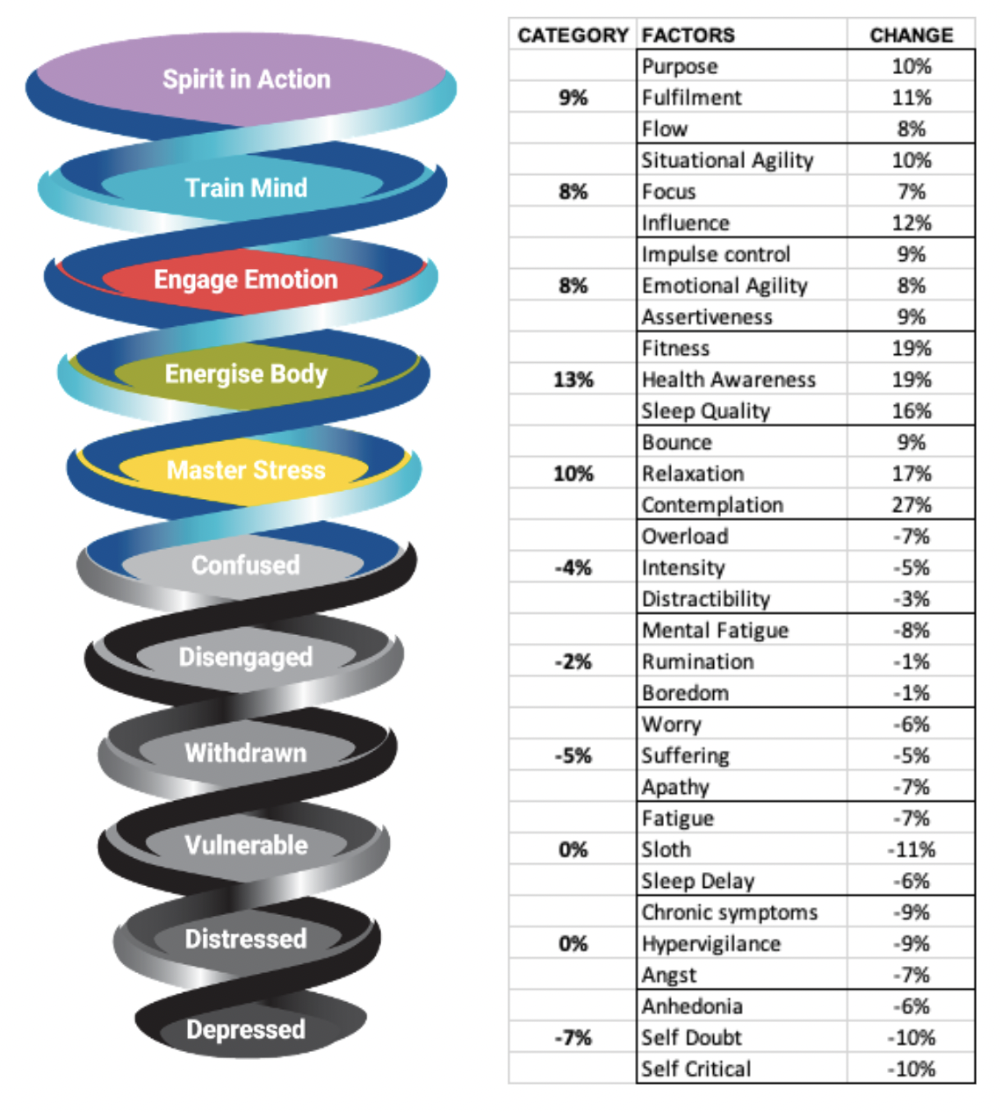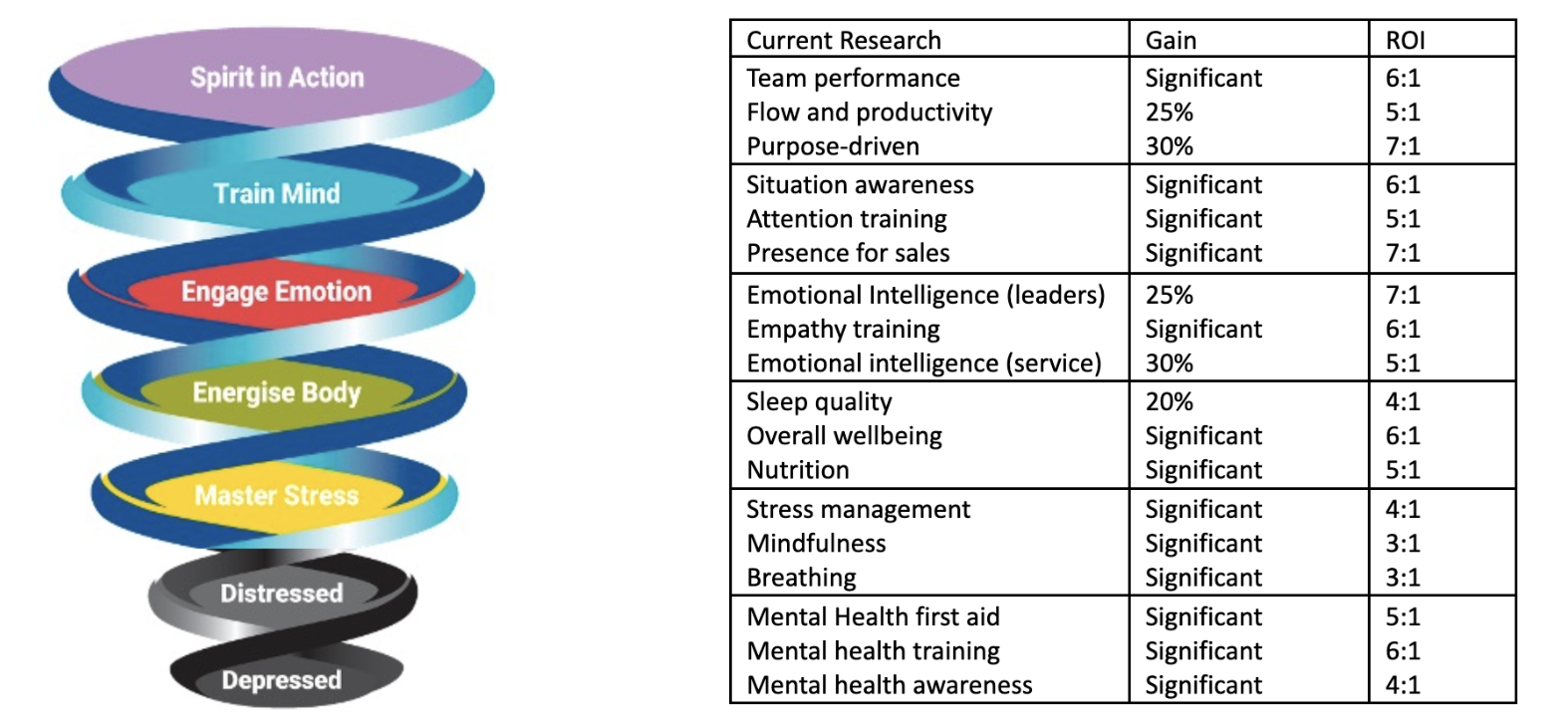
Maximizing ROI Through Resilience Training: A Business Imperative
Leaders invest in well-being and resilience because they are good employers. They care about their people. They hope resilience might improve performance. Steadily accumulating research reveals that these programs show consistently positive returns on investment (ROI). We are leaving money on the table.
This article demonstrates how investments in employee well-being and resilience are obvious opportunities to make more money whilst doing the right thing for people. ROI studies show the value of an investment in net present value (NPV) terms. If an ROI is 4:1 (about average), that means that your investment of $100,000 is worth $400,000 to you on the day you invest.
In this article:
- Defining and organizing investments in resilience and well-being
- What to expect from your investment
- The importance of measurement, evidence, tracking and targeting
Organizations invest billions in resilience, engagement and well-being training. They include physical mental health, physical well-being, stress mastery, emotional intelligence, thinking skills and bounce under pressure. Grand View research suggests that the current spending on organizational well-being is over USD 50 billion and growing.
What is the payback? Gallup reports that we are losing USD 8.8 trillion in productivity. Specifically, they report the following benefits for top-quartile versus bottom-quartile engagement:
- 10% higher customer loyalty/engagement
- 23% higher profitability
- 18% higher productivity (sales)
- 14% higher productivity (production records and evaluations)
- 18% lower turnover for high-turnover organizations (> 40%)
- 43% lower turnover for low-turnover organizations (< 40%)
In this article, we provide evidence for those gains and estimate your return on investment (ROI). Human performance is a complex and developing field, so the objectives are to frame the business case, understand what drives investment, and provide a measure of ROI based on the quality research available.
What is a Resilience Program?
Resilience is a learned set of attitudes, knowledge and skills to bounce in adversity, grow, connect and achieve optimal performance (flow). These capabilities help us recover from depression, improve well-being, connect effectively, and improve productivity. We call it Performance with Care.
People are holistic with body, emotion and mind. Whether in distress or peak performance, these are connected. A pill does not solve depression. The latest psychedelic won’t solve performance. Only integral, evidence-based and practical solutions can meet the diverse needs of people at work. You cannot tick the box with a celebrity workshop.
As purposeful and innovative communities, organizations will inevitably move in this direction. Multiple disconnected initiatives confuse and waste. A resilience program is an integral, evidence-based and practical solution over time to improve employees’ well-being, function and productivity. These individual gains lead to organizational gains.
A resilience program includes:
- Careful consideration and design to meet objectives, including clients and providers.
- Leadership is fully briefed and engaged – enough to walk the talk.
- Well-considered, effective measurement of the factors involved.
- Individual and group feedback to inform training design.
- Targeted training over time to build attitudes, knowledge and skills.
- Measurement of progress over time, adjustment and improvement.
What Motivates an Organization to Invest?
Organizations invest for three reasons. They see a link between resilience and performance, they care about their people, or they believe it will have a financial benefit. Many of our clients strongly believe that it is the right thing to do. Cost is not an issue. They seek to be good employers.
What if resilience investments had a proven ROI? For decades, studies have shown ROI of 3:1 or more (see Appendix). In other words, spending a million would be worth 3 million today (Net present value). If leaders know this, organizations will invest. That is our mission. Resilient people lead to resilient organizations, which together support a resilient planet.
What Does Current Research Tell Us About ROI?
We have grouped current studies into seven major categories of research. We have listed the ROI range for each category and provide a detailed summary of each study in the appendices.
What is Resilience Training Impact?
Resilience training equips people with broad practical skills to bounce and grow under pressure. People with these skills underpin an organization’s ability to adapt, overcome challenges, and flourish. The ROI ranges from 2:1 to 4: 1. In other words, the dollar you invest today is worth between $2 – 4. Five recent controlled studies on isolated aspects of resilience confirm this. See Appendix 1.
Mental Health Training Impact
Good mental health drives engagement, job satisfaction, and overall productivity in forward-thinking organizations. Yet mental illness has become the number one health concern in business. People can learn how mental health can be challenged and improved to increase bounce and well-being. Four recent studies show ROI from 3:1 to 6:1. See Appendix 2.
Stress Management Training Studies
Progress means pressure, and many feel “distressed” at work. To prevail, people must learn to respond to pressure with skill. We call this stress mastery. Four current studies show returns of 2:1 to 4:1. See Appendix 3.
Well-being/Wellness Training Studies
Being well rather than “not sick” is the foundation of good life and productive work. The evidence from Corporate health initiatives over 40 years is consistently positive. The evidence for improved sleep, physical activity, nutrition and lifestyle is incontestable. Recent studies show returns from 3:1 to 6:1. See Appendix 4.
Emotional Intelligence Training Studies
For people to collaborate in teams, emotional awareness, impulse control, empathy, and social skills define the star-performing teams. They are critical for effective leadership and services. These skills are supported by well-being and resilience. Recent studies show 4:1 to 7:1 ROI. See Appendix 5.
Focus and Attention Control Training Studies
It is the mind that pays attention, identifies opportunities and defines solutions. Work is increasingly cognitive. These attention, situation awareness, problem-solving and agility skills have only recently been addressed. Current studies show ROI from 3:1 to 7:1. See Appendix 6.
Performance Studies
Trust, purpose, altruism and flow are high-level drivers that operate best when body, heart and mind function well. These are essential to enlightened organizations (Patagonia), entrepreneurs (Ellon Musk), social entrepreneurs (Greta Thunberg), and benevolent governance. ROI in recent studies ranges from 3:1 to 7:1. See Appendix 7.
Framework, Measurement and Evidence
Resilience, well-being and mental health embrace many topics, complexity and overlap. Measurement and targeting is difficult. In this section, we share with you our Diagnostic and Development Framework, first with an example from our 2023 data and second with the current studies mapped to this framework.
We use 60 Resilience Factors for specific signals on the many physical, emotional and mental inputs to resilience. There are 30 strength factors and 30 risk factors.
We have shown consistent growth in every strength factor and reductions in almost all risk factors over hundreds of programs and thousands of people. To provide a current reference, we have drawn our data from 877 people who completed programs in the first nine months of 2023.
Over this time, the Resilience Ratio—an aggregate measure of resilience—increased from 1.75 to 2.05. The top 10% scored 2.58:1, and the bottom 10% under 0.97:1.
Resilience Institute Diagnostic and Development Framework
The factors improved on a standard Likert scale by the percentages listed. All the strength factors increase, and the risk factors decrease. This is a sample of 33 factors from 877 people who attended a range of simple programs. Each group of factors integrate into a category (the coloured ovals), and the change in each category is shown alongside it:

The overall resilience ratio increased by 17.1%, which is shown in the rightwards shift in the distribution below. There is a 50% decrease in people at risk.

The average investment per person is approximately USD $100. Therefore, the investment cost is $87,700, and the return based on the average at 4:1 would be $350,800.
Matching Current Research to Our Diagnostic and Development Framework
The top three studies in each category are shown with their ROI. Remember, an ROI of 6:1 means that your investment of a dollar is worth six.

Conclusion
The value of resilience in the workplace is strongly supported by scientific and economic evidence. Yes, it is the right thing to do. Yes, it is an investment with a compelling ROI. From the significant return on investment to the less quantifiable yet equally vital aspects like team cohesion, engagement, and customer satisfaction, resilience training is a win-win for employees, employers and the planet. The era of viewing ‘soft skills’ as secondary is over. In a world characterized by rapid change and uncertainty, resilience is a key asset for any organization aiming to not just survive but thrive.
